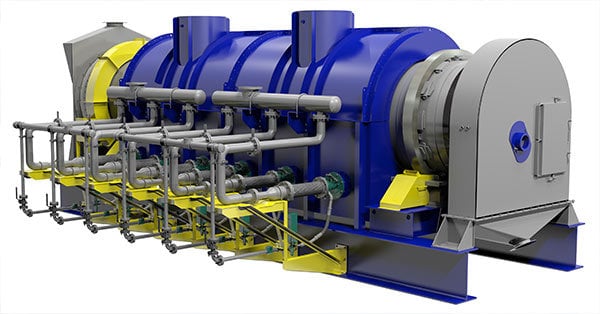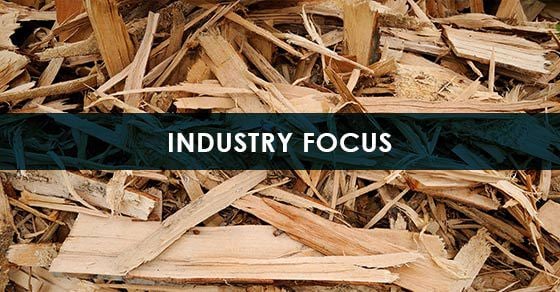Activated carbon continues to attract interest as a way to produce a premium, marketable product from biomass waste. As a powerful adsorbent, the carbon-based material has been applied in everything from water treatment to gold recovery.
The nascent nature of this industry, however, is leaving those interested in producing activated carbon with many questions. As a leading producer of commercial-scale activated carbon kilns, we’ve put together the following overview on these thermal conversion systems to assist in evaluating the viability of an intended process.
Required Capacity
One of the most challenging aspects of an activated carbon operation is the relatively low yield; roughly just 15% of the original feedstock quantity exits the process as product, though output is dependent on the type of feedstock, as well as its carbon content (typically the higher the carbon content, the lower the yield).
As such, material availability and sourcing should be considered at the project’s outset to ensure a reliable source of feedstock can be readily and economically sourced in the long term.
System Infrastructure
While the actual conversion process is fairly straightforward, processing biomass into activated carbon requires a more elaborate system than most anticipate, typically following the progression shown here:
A typical activated carbon production facility consists of the following:
Primary Equipment
Biomass Dryer
In order for biomass to effectively undergo carbonization, the moisture content must be less than 10% (by weight). Since raw biomass typically comes in at anywhere between 40-60% moisture, most facilities require a drying process prior to the actual conversion process.
Biomass drying is typically carried out in a natural gas-powered, direct-fired rotary drum dryer with a combustion chamber.
Carbonization & Activation
The conversion process is carried out in two indirect rotary kilns: one for carbonization and one for activation. An indirect kiln consists of a sealed rotary drum rotating inside of a furnace or heat shroud. A number of burners create several heating zones along the length of the kiln to control the processing temperature inside the drum.
Carbonization
Dried biomass is fed into the carbonization kiln, which is constructed of stainless steel and for a typical operation, ranges in size from 4’ – 13+’ in diameter and 40’ – 110+’ in length . The actual heated length of the kiln varies depending on the size of the unit, but could be anywhere from 30’ to 90+’. Carbonization occurs at around 750°F, at which point most of the impurities are volatilized and the material is transformed into pure carbon.
During carbonization, it may be necessary to inject nitrogen into the kiln to maintain an inert environment and prevent combustion of the carbon component of the feed.
Activation
The carbon material exits the carbonization kiln and is fed to the activation kiln, which operates at considerably higher temperatures and is therefore constructed of high-temperature stainless steel. This kiln is comparable in size to the carbonization kiln.
Activation occurs at around 1,750°F with the injection of saturated steam, which causes any remaining impurities to be volatilized and the material to be transformed into activated carbon.

3D Model of a FEECO Indirect Kiln
Product Cooling
Material exiting the activation kiln is typically at about 1,800°F, and must be cooled to around 120°F prior to any further handling.
Multiple cooling arrangements are available. An indirect rotary cooler is often used to carry out the cooling process, because it prevents any risk of entrainment, or fines becoming swept up in the air flow and exiting through the exhaust gas system (at this point, the material consists of a fine powder).
Support Systems
The equipment listed above covers the primary conversion process, but several systems are necessary to support this process:
Thermal Oxidizer
The carbonization kiln requires a thermal oxidizer, also known as a secondary combustion chamber or afterburner. This system is used to combust any volatile gases generated during carbonization.
Nitrogen Injection System
As mentioned, the carbonization kiln requires nitrogen injection. The dedicated nitrogen supply is injected through a nozzle positioned on the inlet kiln wall. Nitrogen may also be injected around the seals as well to prevent any incoming air.
Boiler System
A boiler system is required to produce the saturated steam that will be injected during the activation process. This system typically consists of either a small or commercial-size boiler, as well as chemical treatment for the feed water.
Dedicated Water Supply
Because the cooler is of the indirect water deluge type, a dedicated water supply is necessary.
Shredding System
The conversion process requires a uniformly sized feedstock for best results (non-uniform sizing results in uneven heating, and therefore produces inconsistent results). Since biomass comes in many shapes and sizes, even from the same source, a shredding system is often necessary on the front end of the process, prior to drying.
Feedstock is shredded into the range of 6mm – 40 mesh, depending on the material.
Ancillary Equipment
In addition to the systems and equipment already mentioned, several other types of ancillary equipment will be needed to support the facility and processing operation. This additional equipment is not usually included in the scope of a budget price, but typically includes:
- Feed storage silos
- Feed conveying
- Screening equipment
- Bagging
- Controls
- Air pollution control
Other Considerations
Activated Carbon Process & Product Development
While the conversion of biomass to activated carbon is relatively simple in theory, in practice it is quickly complicated by the diverse range of feedstock types and the specific source of feedstock’s characteristics.
For this reason, rotary kiln testing in a facility such as the FEECO Innovation Center is an essential step in confirming the physical and economical feasibility of the intended process. Further, testing can be scaled up from batch to pilot scale to further evaluate and optimize the process to produce the exact product specifications desired (carbon content, heating value, iodine number, etc.).
Many variables influence the conversion process and the characteristics of the end product, including:
- Type and species of biomass
- Feedstock bulk density
- Residence time
- Temperature
- Particle size
- Drum slope and speed
Conclusion
The market potential for processing biomass into activated carbon continues to grow. Producers looking to vet the viability of a potential project should first understand the capacity limitations of the business, as well as the scale of the system and all of its necessary components. Those interested in learning more about process or product development for activated carbon production or custom activated carbon kilns should contact FEECO.



